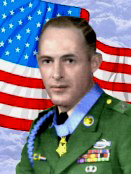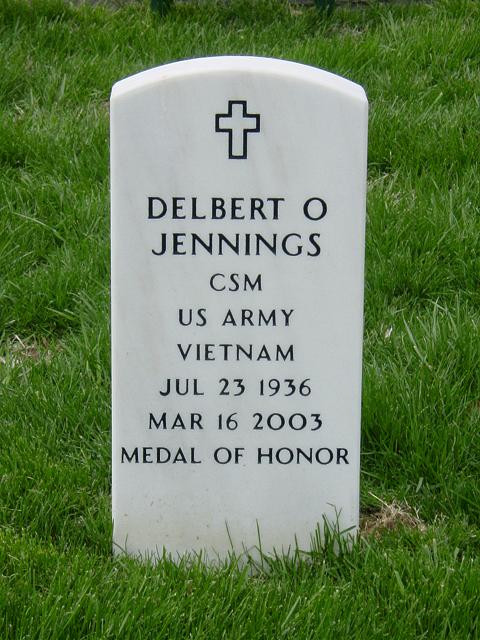Delbert O. Jennings, 66, of Honolulu, a retired U.S. Army Command Sergeant Major, died March 16, 2003. He was born in Silver City, New Mexico. He is survived by son Neal D., mother Etta Mae, brother Donald L. and a grandchild. Private services.
The President of the United States
in the name of The Congress
takes pleasure in presenting the
Medal of Honor
to
JENNINGS, DELBERT O.
Rank and organization: Staff Sergeant, U.S. Army, Company C, 1st Battalion (Airborne), 12th Cavalry, 1st Air Cavalry Division. Place and date: Kim Song Valley, Republic of Vietnam, 27 December 1966. Entered service at: San Francisco, California. Born: 23 July 1936, Silver City, New Mexico.
Citation:
For conspicuous gallantry and intrepidity at the risk of life above and beyond the call of duty. Part of Company C was defending an artillery position when attacked by a North Vietnamese Army regiment supported by mortar, recoilless-rifle, and machinegun fire.
At the outset, S/Sgt. Jennings sprang to his bunker, astride the main attack route, and slowed the on-coming enemy wave with highly effective machinegun fire. Despite a tenacious defense in which he killed at least 12 of the enemy, his squad was forced to the rear.
After covering the withdrawal of the squad, he rejoined his men, destroyed an enemy demolition crew about to blow up a nearby howitzer, and killed 3 enemy soldiers at his initial bunker position. Ordering his men back into a secondary position, he again covered their withdrawal, killing 1 enemy with the butt of his weapon. Observing that some of the defenders were unaware of an enemy force in their rear, he raced through a fire-swept area to warn the men, turn their fire on the enemy, and lead them into the secondary perimeter.
Assisting in the defense of the new position, he aided the air-landing of reinforcements by throwing white phosphorous grenades on the landing zone despite dangerously silhouetting himself with the light.
After helping to repulse the final enemy assaults, he led a group of volunteers well beyond friendly lines to an area where 8 seriously wounded men lay. Braving enemy sniper fire and ignoring the presence of booby traps in the area, they recovered the 8 men who would have probably perished without early medical treatment.
S/Sgt. Jenning’s extraordinary heroism and inspirational leadership saved the lives of many of his comrades and contributed greatly to the defeat of a superior enemy force. His actions stand with the highest traditions of the military profession and reflect great credit upon himself, his unit, and the U.S. Army.
By: Al Hemmingway
Courtesy of the Veterans of Foreign Wars
Staff Sergeant Delbert Jennings did not feel good. His stomach pains had gotten worse, and he had trouble sleeping. Besides his illness, he was worried. His undermanned weapons platoon was assigned to defend the northern sector of the perimeter at LZ (Landing Zone) Bird. It was a large area to defend for a mere 22 soldiers, some of whom were new replacements and had seen no action.
LZ Bird was one of several forward artillery bases that provided support for the 1st Air Cavalry Division in the Kim Son Valley. Many felt Bird was located in an exposed area–“a freak of geography fashioned by the vagaries of a meandering river,” according to one description. From the air, it resembled a T-bone steak. It was 250 meters in length and about 80 meters wide and was bordered on the south and west by the Kim Son River.
A dozen howitzer positions spotted the LZ. The 155mm guns of C Btry., 6th Bn., 16th Artillery, were situated at the northern perimeter, and at the southern tip were the 105mm cannons of B Btry., 2nd Bn., 19th Artillery. Interspersed among the gun positions were infantrymen from C Co., 1st Bn., 12th Inf. Regt., 1st Air Cav Div.
‘Like Sitting Ducks’
Just before Christmas 1966, both sides called a truce to hostilities. However, at 1 a.m. on Dec. 27, the unmistakable sound of incoming mortar rounds were heard. The chattering of enemy heavy machine guns and 57mm recoilless rifles cracked in the night air. Soon, soldiers from the 22nd North Vietnamese Army (NVA) Regiment had successfully breached the perimeter.
“The moon was out and between the rain clouds … and you could see hundreds of NVA, most in single file, coming at us,” wrote Spc. 4 John McGinn, Jr. “I was on the northeast side. I felt like we were sitting ducks.”
Spc. 4 Gary Peasley and Spc. 4 Donald Woods began raking the NVA attackers with M-60 machine gun fire. They stood their ground, enabling Jennings and Staff Sgt. Colmar Johnson to muster a group of GIs to re-establish a secondary perimeter.
As the two NCOs were rallying the troops in their sector, 1st Lt. John Piper and 1st Lt. Charles Campanella emerged from their tent to see 40 to 50 NVA soldiers breaching the southeast corner of the perimeter. Both officers began to withdraw to the gun parapets to defend them. They made it safely to the FDC (Fire Direction Center) and were joined by battery commander Capt. Leonard Shlenker, Jr., 1st Lt. Michael Livengood, 1st Lt. John Reike, Staff Sgt. Carroll Crain and radio operator Spc. 4 Clint Houston.
“Some of the NVA jumped over the trench going to another gun position,” Houston recalled. “Lt. Livengood fired his M-79 as they jumped over. I fired at one NVA coming up the trench yelling at me. I know two of my tracer rounds hit him.”
Courage Saves Lives
As Shlenker’s group was leapfrogging toward No. 1 gun pit, Jennings and Johnson’s men were fighting for their lives. Jennings killed about a dozen NVA and then another three who were attempting to destroy one of the 155mm howitzers.
Jennings’ Medal of Honor citation reads: “Observing that some of the defenders were unaware of an enemy force to their rear, he raced through a fire-swept area to warn the men, turn their fire on the enemy, and lead them into the secondary perimeter.
“He personally led a group of volunteers well beyond friendly lines to an area where eight seriously wounded men lay. Braving enemy sniper fire and ignoring the presence of booby traps in the area, they recovered the eight men.”
Meanwhile, at the gunpit, desperate measures were necessary. “I would look to the rear, then move up, and rest my back on Livengood’s boots,” Houston said. “This ditch was only about 2 1/2 to 3 feet deep. Then Lt. Reike got hit in the throat and the bullet traveled down to his stomach.
“We tried to stop the bleeding as best we could, but the NVA were swarming all around us. We gave him a .45 pistol and told him we would try to keep them off of him as we went for more help.”
As Reike lay dying, Spc. 4 Charles Tournage arrived on the scene. The young medic had been all over the battlefield, helping wounded soldiers. He was completely naked. When the opening shots were fired, he had no time to get dressed.
After giving first aid to Reike, Tournage raced to find additional medical supplies. In his search, he narrowly escaped death. In the darkness, a charging NVA mistook him for a fellow soldier. “As the Viet swerved off on an oblique, Tournage had time to get off one M-79 round that, armed in just the right split-second, hit the target in the middle of the back and tore the North Vietnamese apart,” military historian S.L.A. Marshall wrote in his book Bird: The Christmastide Battle.
Combat was intense, especially when confined to isolated pockets. “We fired our M-60 machine gun for three to five minutes … using 800-900 rounds of ammo before we were overrun,” McGinn explained. “We played dead. It was no use in trying to fight off any more of them. They kicked me and went through my pockets and took my billfold and watch. I lay there praying, waiting to be shot in the head.”
Fortunately, communications had been restored and illumination rounds from LZ Pony bathed the Bird in an eerie light, sparing McGinn’s life.
Spc. 4 William Dunbar had flown in from LZ Pony just the night before. “It is not an easy task to describe what happened since people were running all over,” he recalled, “the loud bursts of weapons, soldiers yelling to each other amidst what looked like a grand finale at a Fourth of July fireworks show.”
‘Screeching Bees’
Artillerymen were busy doing their jobs, too. Piper and Staff Sgt. Robert Underwood loaded a beehive round into one of the 105mm howitzers. Yelling a warning to get down, Piper yanked the lanyard. Instantly, 8,500 flechettes (tiny metal-shaped arrows) tore into the attacking NVA ranks.
“It was so haunting,” Houston remembered. “It screeched like a million bees. I saw a big hole in their ranks, and then I heard screaming. Those bodies were ripped to shreds. Then they fired again with the same results. The assault was stopped dead in its tracks.”
With the enemy momentum halted, the troopers began taking back overrun gun pits. A formation of UH-1 helicopters fitted with ARA (aerial rocket artillery), and several armed CH-47 Chinook helicopters, hammered NVA positions at Bird.
“The sun came up, and the carnage was everywhere” Houston said. “We loaded our dead and wounded on the arriving choppers. The NVA dead were lined up. Blood was running in the ruts all along the LZ. I remember it was so cold and wet. And I will never forget the smell.”
The battle had lasted only an hour. Some 266 NVA soldiers had been killed then and during the retaliatory pursuit. During the same period, the 1st Cavalry Division sustained 58 KIA and 77 wounded. (Of the 199 men on LZ Bird that night, 28 were KIA and 67 WIA while taking out 211 NVA.)
Acts of valor were recognized. Piper and Crain earned the Distinguished Service Cross. The Silver Star went to Shlenker, Campanella, Staff Sgt. Gregerio Nieto, Tournage and Osborne.
S.L.A. Marshall summed up the enemy failure in his book this way: “The NVA failed to deny the defenders the use of the main trench, and in the bunker-to-bunker fighting they were being out-gamed by the few men who stood in their way. The deeper the enemy advanced, the more he was becoming diffused”
Capt. Nguyen Song Phuc of the 22nd NVA Regiment agreed: “It was a disastrous defeat for our side.”
AL HEMINGWAY, a Marine Vietnam veteran, is a frequent contributor to VFW.
JENNINGS, DELBERT O
- CSM US ARMY
- VIETNAM
- DATE OF BIRTH: 07/23/1936
- DATE OF DEATH: 03/16/2003
- BURIED AT: SECTION 7A SITE 157
- ARLINGTON NATIONAL CEMETERY
Michael Robert Patterson was born in Arlington and is the son of a former officer of the US Army. So it was no wonder that sooner or later his interests drew him to American history and especially to American military history. Many of his articles can be found on renowned portals like the New York Times, Washingtonpost or Wikipedia.
Reviewed by: Michael Howard


